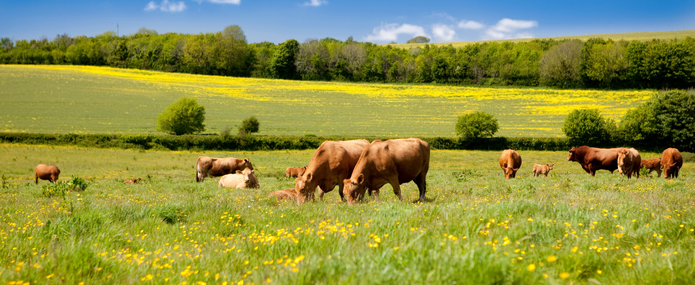The need for, and the urgency of, a transition of our food system to face the triple challenges of conserving biodiversity, improving adaptation to climate change while reducing GHG emissions, and improving diets, is no longer questioned. Over the last 5 years, Iddri and AScA have explored the contribution of agroecology to such a transition at the EU level through the TYFA project. Following a landmark report published in 2018, that demonstrated the technical plausibility and the desirability (in terms of sustainability indicators) of a generalization of agroecology across Europe, the project team has continued to work on three complementary workstreams (link with global scenarios, intra-European regionalisation, analysis of the socioeconomic pathway for change). A new report, released today, confirms the relevance and the potential of an agroecological transition for Europe. Two other reports will shortly follow by September and October.
In September 2018, IDDRI presented the TYFA (Ten Years For Agroecology) scenario (Poux and Aubert, 2018), in which a fully agroecological Europe was modelled using a biophysical simulation tool (TYFAm). EU agricultural systems were imagined as free from synthetic inputs and based on the redeployment of natural grasslands and the extension of agroecological infrastructures (hedges, trees, ponds, stony habitats). At the same time, current human diets, highly unsustainable, shifted towards healthier and more sustainable food regimes. The results showed that this scenario could sustainably feed 530 million Europeans by 2050 (including the UK) and at the same time reduce agricultural sector greenhouse gas emissions, limits feed/food competition, stop imported deforestation associated to soybean, restore biodiversity, and protect natural resources.
As might be expected, this scenario raised many questions. In the last three years, IDDRI modelling team in close collaboration with academic partners (INRAe) and consultancy firms experienced in social analysis (Le Basic) and environmental evaluation (AScA) worked in different directions to further explore the potential implications of the deployment of a large scale “agroecological revolution” in Europe. Three workstreams explored each one of these with a specific questioning that we tried to answer in our analysis.
- What are the implications of the TYFA scenario at the global scale by 2050 and how the TYFA scenario’s impacts inside the EU are sensitive to the pathway of change in food systems in the rest of the world?
- How can the biophysical modelling simulation realised in 2018 be downscaled in each European country and at the landscape level? Are the general results at the EU level still valid at smaller regional scales? And what does it mean for European agrarian landscapes?
- What are the socio-economic implications of TYFA in terms of agricultural transformations at the micro and macro levels: producers’ income, agricultural and agrifood employment and food cost for consumers?
In the first work stream, IDDRI worked in close relationship with INRAE to configure TYFA food systems in a broader world biomass balance model (GlobAgri-AgT, Le Mouël et al., 2018) and analyse the impact of TYFA hypotheses in the EU on the world land use, the EU physical trade balance, the provision of calories and how this might affect the global food security by 2050. The results of this effort are published in the 2021 report An agroecological Europe by 2050: What impact on land use, trade and global food security?. In this report, first, through a retrospective showing how the position of the EU changed over the last decades, we disentangle the idea that the EU is still a major contributor to world food availability and security. Then, we show that because of the reduction of animal proteins consumption and the relocation of vegetal protein production, an agroecological EU adopting a sustainable diet maintains the current level of its agricultural land and better performs in providing nutrients/calories to the rest of the world than it does today.
In the second project regarding the regionalisation of TYFA, AScA consultancy firm took the lead and developed a more spatially explicit modelling tool called TYFAregio. Based on Eurostat data at NUTS2 level, 21 archetypal European agrarian systems were characterised following the criteria of land use, biogeography and relief, yields and yield potential, total production–including grass, density and type of livestock and total animal production. A case study based on TYFAregio regarding the spread of the TYFA scenario in the UK will be published in September in the report Modelling an agroecological UK in 2050: findings from TYFAregio. This modelling analysis suggests that the need to close fertility cycles at regional level would entail a relative despecialisation of UK regions in terms of arable/permanent grassland balance, towards mixed farming. It also strengthens the sustainability of agroecology and makes it a credible option for a future-oriented farm policy agenda for the UK. More generally, TYFAregio finds that soil fertility can be managed at the level of each agrarian system. Along with this analysis, AScA also developed a landscape-oriented representation of the TYFA scenario which will be presented in October 2021.
The third work package related to the economic evaluation of disruptive changes in the agricultural systems is still ongoing. Starting from the idea that existing economic models are currently unable to capture deep structural transformations of farms and food chains and to really consider in their analyses the biophysical constraints such as climate change, biodiversity loss, or the degradation of natural resources, IDDRI team worked in collaboration with Le Basic and developed an alternative methodological approach which combines the biophysical constraints and the socio-economic analysis. A first pilot application of this approach was realised for the dairy and cereal sector in the report Towards a just transition of food systems: Challenges and policy levers for France and is being extended to the meat sector. While the methodology to analyse the impact of the transition on farm income and the cost of food needs further development, the results show that an agroecological transition can deliver positive results in terms of employment, at both the farm and the processing sector levels.


